I had a lot of fun putting this cheese platter together and it is not really difficult to do it yourself, and luck has it that it is always the right time for cheese, whether it is a birthday, a festive holiday, anniversary, whether you have a meeting, a book club evening or just a nice evening with friend, like the upcoming Super Bowl for instance.
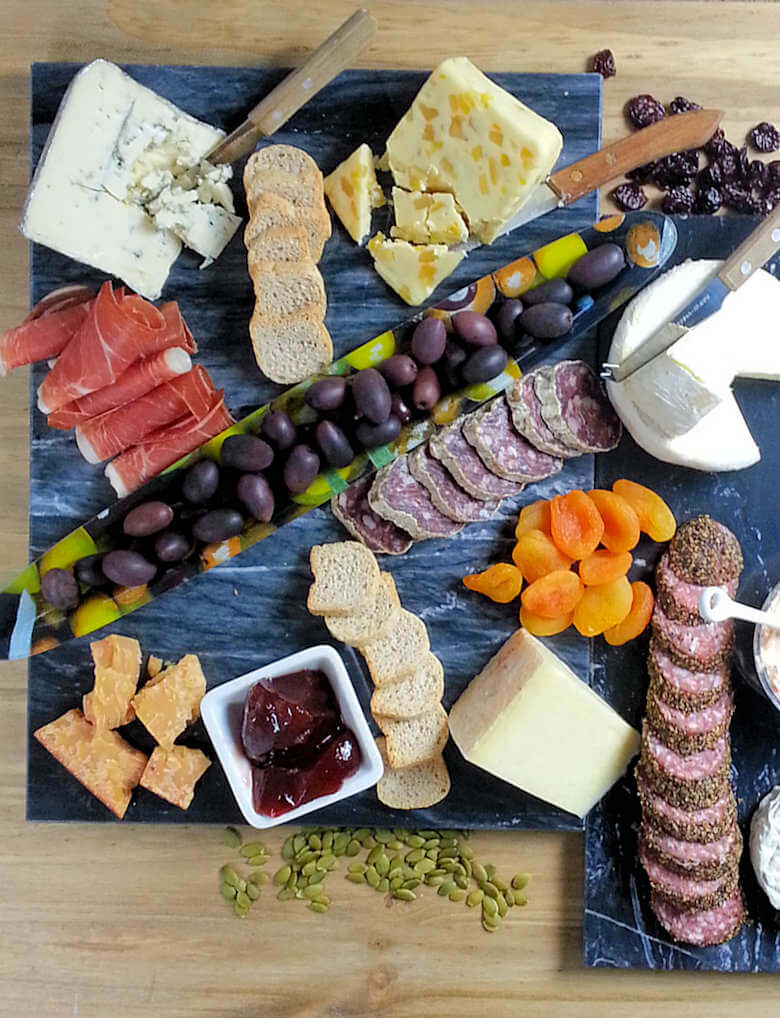
I love cheese; I was born in a country that some people know for its cheese …..; can you guess? …….It is Holland, so for me, a cheese platter, small or large is like an ode to the cheese and the cheesemakers; a tapas board of cheese, a celebration of aromas, flavor, colors, textures and adventures. For this post I created a large cheese platter of 10 different cheeses not something you serve on a regular basis – I just wanted to show you an example and you and I can come up with many, many more.
It is going to be a long post, so stick with me; it may come handy when you have a party or during holiday season.
In my philosophy a cheese platter is never just cheese. It always has other items as well, like meat (salami, prosciutto, pate), nuts, dried fruits, seeds, olives, veggies, fresh fruits, crackers, bread, toast, chocolate, you name it; so many options, so many choices, but pick accompaniments that pair well with the main attraction of the board.
Building your own winning cheese platter; there are a few basic questions you should ask yourself before you start selecting the cheeses and accompaniments. This questions and suggestions are mine and I don’t consider myself an expert, however, I do sell cheese for many years already and have helped many people creating cheese platters in a successful way. I do realize that I will not cover everything, that you may have a different opinion, and I would love to hear what you have to say.
Let’s list a few questions you may have and I will answer them later on with my suggestions.
- What is the occasion? Is it something official (like your partner’s boss is invited for dinner), do you want to impress somebody (your friends know you’re a foodie and look at you for guidance) or is it something casual (girls or guys night out, super bowl party where the eyes are glued to the TV set, rather than your cheese board).
- How many people will be enjoying your cheese platter? How many adults and how many kids?
- Is your cheese platter an appetizer, an after-dinner course or the main event?
- What do you know about your guests? Do they follow a particular diet, life-style, any food allergies or intolerances? Think about gluten-free, low salt, vegetarian or vegan, nut allergies. What do you know about their preferences; do they like goat cheese, or blue cheese. Are they adventurous eaters, in other words, not afraid to try something new? Are they big eaters, or small eaters or calorie counters.
- How much do you want to spend?
- Which cheeses to buy?
Now we need to find answers and suggestions to these questions?
Let’s start with the last question first. Which cheeses should go on a platter? And the answer is as easy or as difficult as you want it to be. Easy because you will go to your favorite store and ask them for options, or you just go with the flow, buy whatever you can find that looks OK; it is your cheese platter, so you can buy whatever you want. The slightly more difficult route is to realize there is some logic, some science in a certain combination/order of cheeses on a cheese platter.
When building your cheese platter, you need to think about texture (soft, hard), type (blue, aged, bloomy, stinky), type of milk (goat, cow, sheep), and flavor and on top of that you can also consider origin as an additional variety or even raw milk vs pasteurized milk cheeses. You could also think about a certain theme of your cheese platter, let’s say a Spanish cheese board or a cow’s milk cheese board, a blue cheese board.
When you build a general cheese platter, start with a soft and mild flavor, like a goat cheese log, then you could choose a brie-type cheese (St. Andre, Mt Tam, Green Hill, Triple Creme Brie) or an cheese like Bonne Bouche (a soft, aged, wrinkled goat cheese). From there you move on to a harder and more flavorful cheese, like an aged Gouda, a cheddar, a Manchego, an alpine cheese, like a Gruyere, Comte, Fortsonia, Pleasant Ridge, Raclette. Your last step can be a blue cheese (Roquefort, Point Reyes Original Blue, Fourme d’Ambert, Blue Stilton etc), or a washed rind (stinky) cheese, like Munster, Epoisses, Grayson, Taleggio.
Of course when you have a buffet, you cannot control who is eaten what when, but when you serve a small platter after dinner, you could steer your guests to eat from mild to strong. Starting in the opposite direction, with the strong cheese, you risk that you won’t taste the mild cheese anymore 🙂
When your cheese platter is huge, you can add other cheeses as well, like a very old Gouda, that crumble while you look at it, a white stilton with fruit, a pimento cheese, a flavored cheese, one of my favorites, Barely Buzzed; this is a cheddar-type cheese rubbed with honey and coffee.
You see on my cheese platter, I’ve added toast, honey, jelly, nuts, dried fruits, ham and salami and seeds.
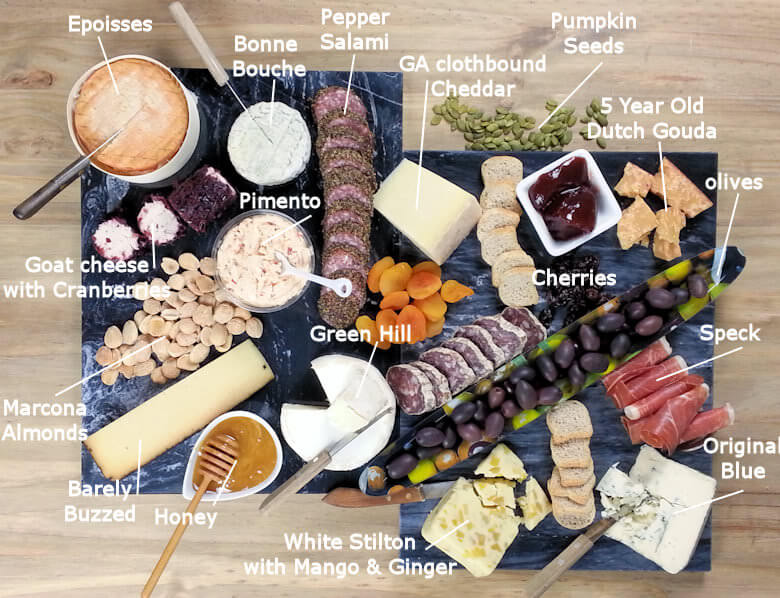
Now you have an idea about the various cheeses you would like to find (and if you can’t find them near you, there is always my shop and see what you like :-)). You’re not there yet, there are still some thing to consider, remember the other questions?
Here are the suggestions:
- When somebody important is coming to dinner, you would like to offer an elegant and small cheese platter; 2-3 cheeses max. Remember you just slaved in the kitchen for a lovely dinner, so now you only want the icing on the cake ; the cheese on the platter. Serve high quality cheese, elegant small wedges and some toast and dollop of jelly or spread or honey. Suggestion? A brie-type cheese (Mt Tam or a Triple Creme Brie or a Green Hill) or a soft goat cheese (there are many small goat cheese logs in various flavors). For the second cheese, buy a bold, firm cheese like a Comte, or a aged Gouda or a flavorful cheddar. Last but not least, add a small piece of blue cheese; I would go for safe here, because you may not know whether they like blue and some blues are perfect in that role (a Point Reyes Original Blue or a French Fourme d’Ambert). I would stay away from the Roquefort-type blue cheese as they are strong in flavor and salty and some people think the cheese has a strong aroma; let’s say it is an aggressive, assertive cheese and not everybody likes that. So be on the safe side and chose a milder blue cheese.
- Obviously, the number of people is important, but equally important is the amount you need per person; and that amount is not carved in stone, however, the general rule of thumb is 1-1.5 oz. per cheese per person. So, if you have 8 people, you need 8 oz. of each cheese on your board.
- Next item to help you calculation is the course in which you serve the cheese. Is it an appetizer, an hors d’oeuvre, a dessert or a hours long party. A winning cheese plate as an appetizer (before dinner) needs 3-5 different cheeses (and I would calculate with even less than 1 oz. per cheese per person). You don’t want everybody to be full before you main course starts. An hors d’oeuvre is quite similar to an appetizer: 4-6 different cheeses and 1 oz. per cheese per person. For an after dinner cheese platter, I would suggest to serve 3-4 different cheeses and again 1 oz. at the max. When you have a long party and all you serve is a large cheese, meat, nibble, veggies, fruit and whatever else platter then of course the sky may be the limit.
- Dietary and other restrictions or limitation or preferences. As a host it is important to know who’s coming to dinner or to your party. In a perfect world you would like to know what they like or better what they do NOT like; whether your guests have dietary restrictions, health issue or certain preferences. You don’t want to serve peanuts to someone who has a nut allergy; you don’t want to serve bread to a person with gluten intolerance or meat to a vegan. This requires a little bit of research on both ends; the people who you invited as well as the products you would like to serve. Today, a lot if known about the ingredients, especially when you’re talking about US-made products. It may be less clear with imported products, as most products will show the minimally required ingredients list, but if you need to know more details, you may need to call them and test your French, Italian, Spanish or Greek language skills. Alternatively, pick a local alternative.
- If there are no dietary restrictions, then try to find out what they like and how adventurous they are. In other words, can you try a fancy cheese, would you guest like that, or would they turn away everything they don’t know. Are they willing to expand their horizon or are they stuck with what they know. I am always slightly hard headed and hopeful at the same time, hard headed because I don’t want to be stuck in the same old over and over again; and hopeful that other people share that enthusiasm to try something new, to explore.
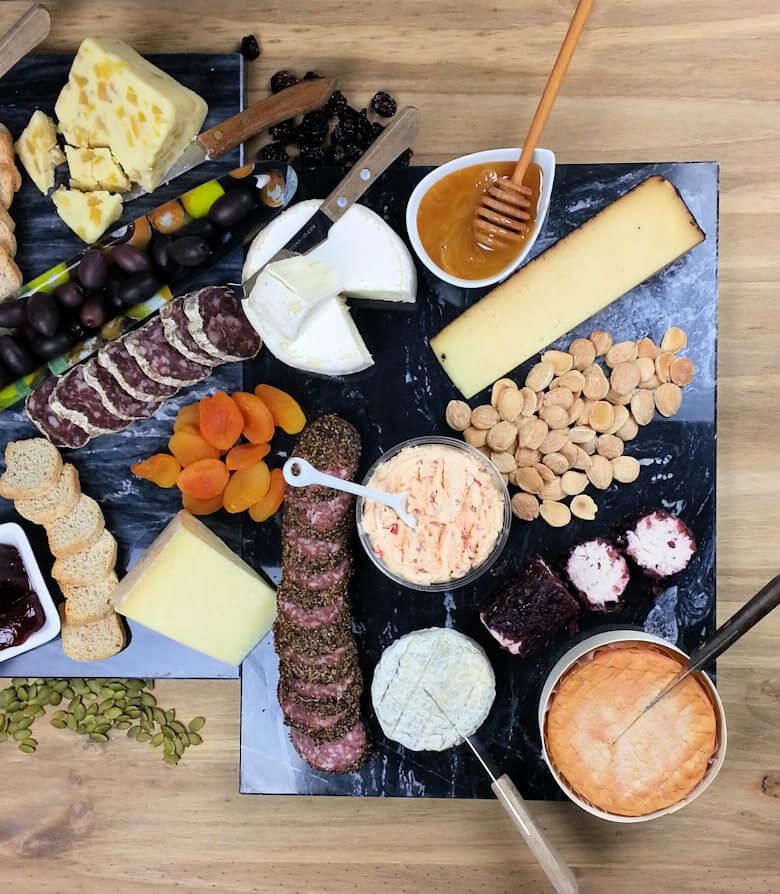
6. Last but not least. Budget; how much are you willing and able to spend and you winning cheese platter. A few rules of thumb again. In general, imported cheese is more expensive than local cheese; cheese from large factories are less expensive than from small cheese makers. Small cheese makers still do a lot by hand, and most likely have a more labor-intensive process and they produce less per day than the huge factories and that drives up the price. One is not necessarily better than the other, just different.
This was a long post. I am glad you made it all the way through. I just needed to get this of my chest; there is so much out there, so many different cheeses and every time I see a new one, I cannot wait to try it. I hope that my suggestion help you and not scare you. Try every now and then a cheese you never tried before, even if it is just a small piece and don’t be put off by look or smell. Just go for it, that is the best way to expand your horizon.


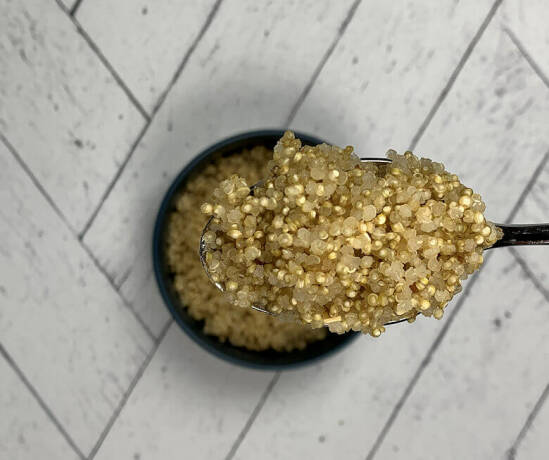
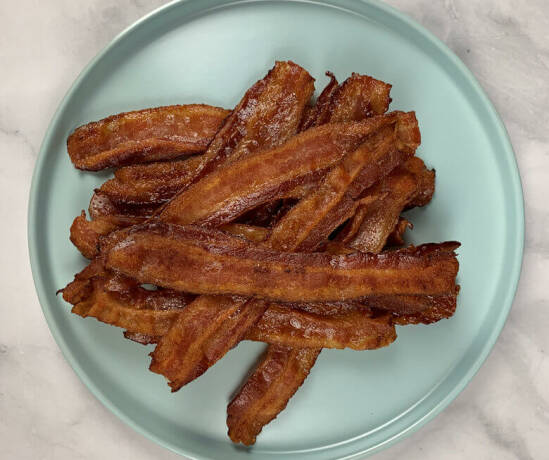
No Comments